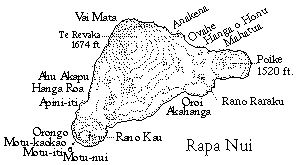
Sighting at Island at Sea
An island at sea may be difficult to distinguish from a cloud at the horizon. Even on a clear day, an island is difficult to see from a distance: a low island such as an atoll, can be seen from 8-10 miles away; a high island, such as the island of Hawai'i, nearly three miles high, can be seen from 100 miles away.
The formula for seeing an object over the curvature of the earth is the following:
"If a mountain peak is 'H' feet high and we are standing 'h' feet above the water, then we will first see the tip of the mountain on the horizon (in clear weather and calm seas) when we are 'D' nautical miles from the peak when you figure 'D' from the equation: D = (the square root of H) + (the square root of h)" (David Burch, Emergency Navigation, Camden: International Marine, 1986. 202-203).

The highest point on Rapa Nui is Mt. Te Revaka at 1674 ft. The square root of 1674 is 41. On the deck of the canoe, a person stands about 9 feet above the water. The square root of 9 is3. Thus he can see the tip of Te Revaka from a distance of 44 miles.
By climbing the mast of the canoe, the observer might increase his height above the water to 25 feet. The square root of 25 is 5, so he can see the tip of Te Revaka, under ideal conditions, from a distance of 46 miles.